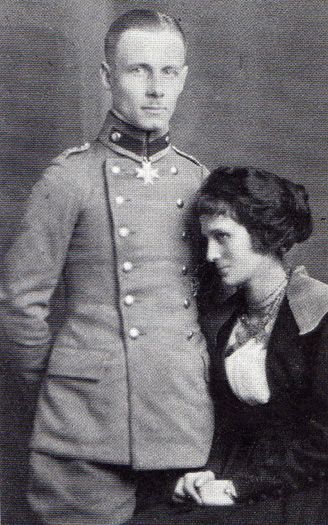
Then WWI Lieutenant Erwin Rommel, wearing his Pour le Mérite, standing next to his wife. The Pour le Mérite, known informally as the Blue Max, was the German Kingdom of Prussia’s highest order of merit during WWI awarded strictly as a recognition of extraordinary personal achievement, rather than as a general marker of social status or a courtesy-honor.
The map above shows the path of Lieutenant Rommel’s battalion from Tolmin to Mount Matajur on the days of 24-25-26 October 1917
Following the Mount Cosna battle Rommel was able to get a few weeks’ leave, going to the Baltic with Lucie (whose name he shortened to ‘Lu’ in his letters) to rest and recuperate, which he undoubtedly needed after such a strenuous campaign. He returned to the battalion in October 1917, by which time they had moved from Romania to Austrian Carinthia on the Italian Front. It would be here that Rommel would be awarded the highest German decoration, the Pour le Mérite, for capturing Monte Majur, the key Italian position, during the twelfth battle of Isonzo (also known as the Battle of Caporetto), which would result in a major Italian defeat and rout.
Briefly, what happened was that Rommel, who had been given command of three rifle companies and one machine-gun company, known as the ‘Rommel Detachment’, was ordered to follow up the first phase of the action, then once the River Isonzo had been crossed and the first Italian line breached, they would take over as advance guard. The attack began in pouring rain on 24 October, after a 1,000-gun preparatory barrage, and the first phase was completely successful. Soon Rommel’s force, now in the lead, reached steeply wooded slopes, leading to the second Italian line. Instead of making the obvious approach, Rommel took his men up a steep gully on the left, then found an unguarded path into the Italian positions, overcoming any Italian outposts he found on the way. By evening they had reached the third enemy line and could see the main Italian positions several hundred feet higher up on the Monte Majur ridge. Rommel was then ordered by the battalion commander of the Bavarian unit on his immediate left, to come under his command as support for an assault on the ridge the following morning. Rommel initially refused, stating that his orders came only from Major Sprosser, who was senior to this particular battalion commander. Nevertheless the order stood, namely that he should follow-up the Bavarian assault and then occupy the ground they took. Rommel was clearly most unhappy, and while his men were resting that night, he worked out his own plan.
Major Sprosser and the rest of the battalion arrived at 0500 hours and agreed to Rommel’s plan, which was to move west, well clear of the Bavarians and attack a different section of the ridge. Just before dawn Rommel, now commanding two rifle companies and one machine-gun company, set off, while Sprosser reached ‘an understanding’ with the Bavarian commander! Infiltrating through the Italian positions, the ‘Rommel Detachment’ first captured an artillery battery, then pushed on, after leaving part of their force (roughly one company) in the gun position. Later when this company was counter-attacked by an Italian battalion, he returned, took the enemy in the rear and forced them to surrender, taking more than 1,000 prisoners which he sent back under guard. The rest of the Gebirgsbataillon arrived and were led forward by Rommel some two miles in single file and succeeded not only in capturing a supply column, some 2,000 Bersaglieri troops and 50 officers, but also in cutting the main enemy supply route. Next Rommel boldly went on to the main Italian positions, which he entered with just a handful of riflemen, calling upon the enemy to surrender – 43 officers and more than 1,500 soldiers complied! Finally, Rommel and his remaining men scaled Monte Majur from the rear, captured the dominating ridge and took the Italians defending it prisoner. In more than three days of constant fighting Rommel’s force had taken more than 150 officers and 9,000 soldiers prisoner, capturing 81 guns into the bargain. Shortly afterwards, with just six men, Rommel swam the Piave by night, then walked into the village of Longarone and took the surrender of the entire garrison!
This was to be his last action and for it and his other exploits he was awarded the Pour le Mérite as was his battalion commander, the redoubtable Major Sprosser. In addition, a Gebirgsbataillon officer named Schorner was awarded the same decoration, allegedly for having captured Monte Majur, an honour which Rommel clearly considered belonged to the ‘Rommel Detachment’ alone. Rommel would thereafter be attached to a higher headquarters as an assistant staff officer, following ‘… with heavy heart’ the battles in which the mountain battalion took part during the rest of the war. In closing his book Infantry Attack!, Rommel was clearly already thinking of battles yet to come, when he says that the last resting-places of the German soldiers who had followed the path of duty to the bitter end should be:’… a constant reminder to us, who remain behind and to our future generations that we must not fail them when it becomes a question of making sacrifices for Germany’. Could he have ever guessed how complex it would be for him to make his own personal sacrifice for the Fatherland?